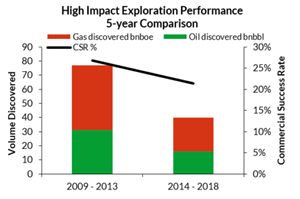Supermajors lead the way in high impact exploration
ABERDEEN -- The largest oil companies are playing an increasingly important role in high impact exploration but performance was down in 2018, limited by a lack of depth in the quality of global drilling opportunities, according to experts at research consultancy, Westwood Global Energy Group.
It’s 10th annual ‘State of Exploration’ report reviewed global conventional exploration over the last five years and looked ahead at the prospects for 2019.
The report reveals that the industry is following a twin track strategy, increasing short cycle exploration over the period in mature basins with existing infrastructure whilst maintaining the hunt for new petroleum provinces, particularly in deep water.
Companies are also moving away from onshore frontier drilling opportunities in areas such as sub-Saharan Africa, due to the time (16 years or more) that some have taken to commercialize. Above-ground challenges including lack of infrastructure and political/regulatory hurdles are effectively ruling these out, together with an anticipation of the energy transition for some companies.
Other key findings from the State of Exploration report are:
- Exploration drilling increased by nearly 30% in 2018 compared to 2017 but performance was down, with fewer big discoveries and a lower commercial success rate.
- Discovered volumes from high impact drilling fell overall by 50% in the 2014-2018 period compared to the previous five years.
- In 2019, high impact drilling is forecast to increase by 20% to around 80 wells, with more high impact wells planned in maturing and mature plays, especially North West Europe and Mexico.
- Supermajors participated in over 50% of the high impact wells in 2018 (up from 34% in 2015) and over 70% of high impact wells in 2019 to-date.
Dr. Keith Myers, president research for Westwood Global Energy Group, explains the findings. He said, “Whilst exploration is recovering, it’s from a very low base. There’s an acknowledgement amongst many exploration companies that it may never again reach 2014 levels.
“There are three main reasons for this. First, the quality of the drilling portfolio globally is declining overall; despite improved drilling numbers there has been decrease in discovered volumes, average discovery size, and success rates. Second is the competition from the U.S. onshore for reserves replacement capital. Third is the looming energy transition away from fossil fuels that is starting to impinge on exploration thinking.
“The competitive landscape is changing with the largest companies like Total, Equinor and Exxon now leading the way on conventional high impact drilling, which is forecast to increase by 20% this year. At the same time, mature regions such as North West Europe are seeing a renaissance, as explorers focus on trying to find more hidden gems.”
The State of Exploration Report covers all high impact and frontier drilling, key discoveries of 2018, key plays explored and all frontier drilling. Exploration performance trends were analysed using a benchmark group of 36 international E&P companies that participated in 756 conventional wildcat wells between 2014 and 2018, drilled at a cost of $28.3 billion and discovering 22.4 Bbbl of oil and gas.




